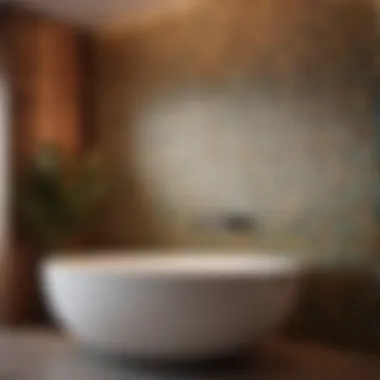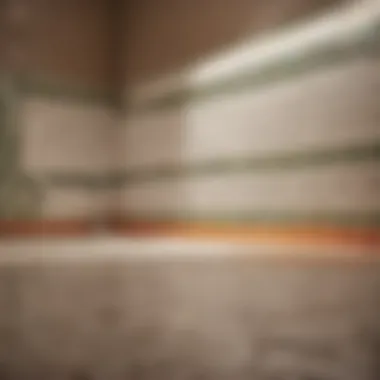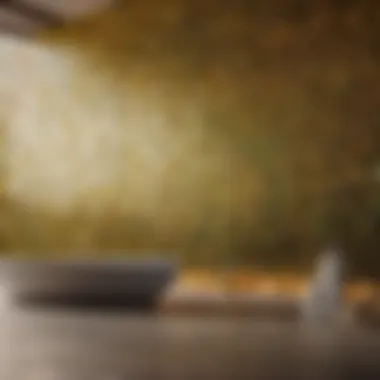Materials:
- Ceramic tiles - Quantity: 30 pieces, Size: 12x12 inches, Material: Ceramic, Color: White
- Tile adhesive - Quantity: 1 gallon, Brand: XYZ Adhesives, Waterproof
- Grout - Quantity: 1.5 pounds, Color: Gray, Water-resistant
- Tile spacers - Quantity: 50 pieces, Size: 1/8 inch
- Tile cutter - Type: Manual, Size: 24 inches
- Notched trowel - Size: 1/4 inch, Material: Steel
- Sponge - Quantity: 2, Material: Cellulose
- Level - Size: 24 inches, Material: Aluminum
- Tape measure - Length: 25 feet, Metric and Imperial measurements
- Safety glasses - Anti-fog, UV protection
DIY Steps:
- Planning: Measure the wall area, calculate the number of tiles needed, select tile design and color.
- Preparation: Ensure the wall is clean and dry, gather all materials and tools, protect surrounding areas with drop cloths.
- Applying adhesive: Use the notched trowel to spread adhesive on the wall evenly, work in small sections to prevent drying.
- Tile installation: Place tiles with spacers in between, press firmly to ensure proper adhesion, use the level to check alignment.
- Grouting: Mix grout as per instructions, apply with a rubber float, remove excess grout with a damp sponge.
- Finishing touches: Clean tiles with a dry cloth, allow grout to cure, seal grout if necessary.
Technical Aspects:
- Timing: Allow 24 hours for adhesive to set, 48 hours for grout to cure.
- Tools: Ensure proper ventilation during adhesive and grout application, use safety glasses to protect eyes.
- Techniques: Maintain consistent spacing between tiles, check alignment regularly with the level, work efficiently to prevent adhesive from drying.
DIY Project Process:


- Start by measuring and planning the layout for precise tile placement.
- Apply adhesive in a consistent manner, ensuring adequate coverage for strong tile adhesion.
- Take caution when cutting tiles to fit corners or edges, use the tile cutter with precision.
- Regularly clean excess grout during application to avoid staining tiles.
- Troubleshooting Tips: In case of uneven tiles, gently adjust position before adhesive sets completely.
Understanding the Basics of Tiling


Types of Tiles for Bathroom Walls
Porcelain Tiles
Porcelain tiles are renowned for their durability and versatility. They are a popular choice for bathroom walls due to their ability to withstand moisture and daily wear and tear. The key characteristic of porcelain tiles lies in their low porosity, making them highly resistant to water and stains. This quality makes them an excellent choice for wet areas like bathrooms. Although porcelain tiles are a bit more expensive compared to other options, their long-lasting nature and low maintenance requirements justify the investment.
Ceramic Tiles
Ceramic tiles offer a wide range of colors, patterns, and designs, making them a versatile choice for bathroom wall tile installations. Their affordability and ease of maintenance are key advantages that appeal to homeowners. The key characteristic of ceramic tiles is their heat and moisture resistance, making them a practical solution for bathrooms. However, ceramic tiles may be more susceptible to chips and cracks compared to porcelain tiles, so proper care is essential to maintain their appearance.
Natural Stone Tiles
Natural stone tiles, such as marble or travertine, exude elegance and luxury in bathroom spaces. The key characteristic of natural stone tiles is their unique veining and texture, adding a touch of sophistication to any room. While natural stone tiles offer a timeless appeal, they require regular sealing to prevent stains and water damage. Despite being a higher-end option in terms of cost, natural stone tiles can elevate the aesthetic of a bathroom significantly, creating a luxurious ambiance.
Factors Influencing Tile Selection
Durability
Durability is a critical factor to consider when selecting tiles for bathroom walls. Tiles that possess high durability can withstand the rigors of daily use without showing signs of wear and tear easily. Opting for durable tiles ensures longevity and minimizes the need for frequent replacements, ultimately saving on maintenance costs in the long run.
Aesthetics
Aesthetics play a significant role in tile selection, as the visual appeal of tiles contributes to the overall ambiance of the bathroom. Choosing tiles that align with the desired aesthetic theme, whether it's modern, traditional, or contemporary, can enhance the overall look of the space. Homeowners should consider factors like color, pattern, size, and finish to achieve a cohesive and visually pleasing result.
Water-Resistance
Water-resistance is crucial in bathroom environments where tiles are constantly exposed to moisture. Opting for water-resistant tiles ensures that the walls remain protected from potential water damage, mold, and mildew growth. Tiles with proper water-resistant properties not only maintain their appearance over time but also contribute to a healthier indoor environment by preventing moisture-related issues.
Calculating Material Costs


In the realm of tiling a bathroom wall, calculating material costs stands as a pivotal aspect that demands meticulous attention. This section delves into the crucial foundation of understanding the financial outlay required for the project. By comprehensively breaking down the expenses involved in acquiring the necessary materials, individuals can effectively plan and budget for their bathroom renovation endeavors. Calculating material costs ensures transparency and allows for optimal allocation of resources, setting the tone for a successful and cost-effective tiling project.
Cost of Tiles per Square Foot
Porcelain Tiles – Average Prices
Porcelain tiles, known for their exceptional durability and versatility, play a significant role in dictating the overall expenditure of tiling a bathroom wall. Their average prices are influenced by factors such as quality, design intricacy, and size variations. Porcelain tiles' ability to mimic various materials like marble or wood while offering superior water resistance makes them a popular choice for bathroom renovations. Despite being slightly pricier than ceramic tiles, the long-term benefits of porcelain tiles, including ease of maintenance and longevity, make them a worthwhile investment for individuals seeking a premium solution for their bathroom walls.
Ceramic Tiles – Price Range
Within the realm of tiling projects, ceramic tiles present a diverse range of price options that cater to various budget constraints. The price range of ceramic tiles is influenced by factors such as design complexity, size, and brand reputation. Their affordability, coupled with a wide array of design choices, makes them a versatile and cost-effective option for bathroom walls. While ceramic tiles may lack the robustness of porcelain, their adaptability and cost efficiency make them an attractive choice for individuals looking for stylish yet budget-friendly tiling solutions.
Natural Stone Tiles – Cost Variations
Natural stone tiles introduce an air of luxury and elegance to bathroom walls, albeit at a higher cost compared to porcelain and ceramic alternatives. The cost variations in natural stone tiles stem from factors such as rarity, size, and quality of the stones used. Their unique and distinct patterns add a touch of sophistication to any space, making them a desirable option for those prioritizing aesthetics in their bathroom design. However, the higher cost and increased maintenance requirements may sway individuals towards more affordable tiling options unless they are willing to invest in the timeless beauty that natural stone tiles exude.
Additional Material Expenses
Expanding beyond the tiles themselves, additional material expenses encompass various components essential for a successful tiling project. These supplementary costs, including grout and adhesive expenses, sealer costs, and the procurement of tools and equipment, are instrumental in achieving a seamless and enduring tiled bathroom wall.
Grout and Adhesive Costs
Detailed per-square-foot analysis at play regarding grout and adhesive expenses is imperative for a comprehensive understanding of the incremental costs involved in the tiling process. Grout and adhesive costs are determined by factors such as quantity, quality, and application method. The selection of compatible grout and adhesive materials ensures the longevity and stability of the tiled surface, underlining their crucial role in the overall tiling project. While these expenses may seem minor compared to tile prices, their impact on the final outcome and durability of the installation should not be underestimated.
Sealer Expenses
Sealer expenses are a critical element in safeguarding the integrity and longevity of the tiled wall. The type of sealer chosen, be it penetrating or topical, and its application methodology directly influence the overall costs incurred. Quality sealers provide a protective barrier against moisture and stains, enhancing the lifespan of the tiles and maintaining their aesthetic appeal. While sealer expenses may add an additional cost layer to the project, their role in preserving the tiling investment cannot be overlooked, making them a necessary component of the tiling budget.
Tools and Equipment
A thorough examination of the tools and equipment required for the tiling process sheds light on the operational costs associated with bathroom wall renovation. The essential tools encompass tile cutters, spacers, trowels, and safety gear, while larger equipment like wet saws may be necessary for more intricate designs. Investing in high-quality tools not only ensures a smoother installation process but also contributes to the precision and overall quality of the finished project. While the upfront costs of tools and equipment may seem substantial, their long-term benefits in terms of efficiency and finishing finesse justify their inclusion in the overall material expenses for tiling a bathroom wall.
Factoring in Labor Charges
When it comes to tiling a bathroom wall, factoring in labor charges is a crucial aspect that can significantly impact the overall cost of the project. Labor charges encompass the fees associated with hiring professionals to install the tiles, ensuring a high-quality and aesthetically pleasing finish. By understanding the breakdown of labor costs, individuals can make informed decisions regarding their budget and project timeline. It is essential to consider labor charges as they play a pivotal role in determining the final expenditure and the overall success of the tiling endeavor.
Average Labor Costs
Labor costs for tiling projects typically vary based on several factors, such as the location, complexity of the design, and the experience level of the installer.
Hourly Rates
Hourly rates are a common method of charging for tiling labor. Professionals may charge hourly rates ranging from $50 to $100, depending on their expertise and the scope of the project. Hourly rates provide transparency in billing and allow homeowners to track expenses more efficiently. While hourly rates may seem more straightforward, they can add up quickly, especially for intricate designs or large wall surfaces.
Installation Charges per Square Foot
Alternatively, some installers prefer to quote installation charges per square foot. This method offers a more standardized approach to pricing and can be beneficial for large bathroom walls where the overall square footage determines the labor cost. Installation charges per square foot provide a clear estimate of the labor component of the project, making it easier for homeowners to assess the total expenses involved. However, variations in square footage or complexities in installation may influence the final cost.
Cost Variations Based on Complexity
The complexity of the tiling project significantly impacts labor costs and overall expenses. Different factors contribute to cost variations, such as the intricacy of the design and the preparatory work involved in the tiling process.
Basic Installation vs. Intricate Designs
Basic tiling installations, such as laying tiles in a simple pattern, are generally more affordable compared to intricate designs that involve specialized cutting or unique layouts. Intricate designs demand more time and precision from the installer, leading to higher labor charges. Homeowners opting for intricate designs should be prepared for increased labor costs due to the detailed work involved.
Removal of Old Tiles
The removal of old tiles before installing new ones also affects labor costs. This preparatory task requires time and effort to ensure a clean and level surface for the new tiles. While removing old tiles can increase labor expenses, it is a necessary step to guarantee the longevity and quality of the tiling job. Homeowners should factor in the costs associated with tile removal when budgeting for their bathroom wall tiling project.
Estimating Total Expenses
In the realm of tiling a bathroom wall, accurately estimating total expenses is a crucial aspect that demands meticulous attention. Whether you are a seasoned DIY enthusiast or a homeowner entrusting the project to professionals, understanding the financial scope is paramount to avoid budget overruns and ensure a smooth renovation process. The estimation of total expenses encompasses a comprehensive breakdown of both material costs and labor charges, delving deep into the intricacies of budget planning for a successful project outcome.
Sample Cost Breakdown
Material Costs vs. Labor Charges
Delving into the intricate balance between material costs and labor charges offers a profound insight into the financial facets of tiling a bathroom wall. Material costs, including the price of tiles, grout, adhesive, and sealers, constitute a significant portion of the overall expenses. On the other hand, labor charges, comprising hourly rates and installation costs, reflect the skilled workmanship essential for a professionally executed tiling project. The interplay between material expenses and labor fees showcases the symbiotic relationship between quality materials and expert installation - a synergy crucial for achieving a durable, aesthetically pleasing bathroom wall.
Additional Costs to Consider
Apart from the fundamental material costs and labor charges, there exist additional expenses that merit consideration when estimating total project expenditures. Factors like the removal of old tiles, specialized tools and equipment, as well as unforeseen contingencies, play a pivotal role in shaping the final budget. While these supplementary costs may seem ancillary, overlooking them can lead to financial surprises during the project execution. Thus, a comprehensive analysis of additional expenses ensures a well-rounded estimation of total costs, fostering financial transparency and preparedness.
Budgeting Tips for Tiling Projects
Setting Realistic Budgets
Setting realistic budgets is not merely a financial exercise but a strategic approach to aligning project goals with available resources. By meticulously assessing material costs, labor charges, and hidden expenditures, homeowners can establish a pragmatic budget that accounts for potential contingencies. The process of setting realistic budgets involves research, price comparison, and an understanding of market trends to ensure that the allocated finances reflect the desired quality and outcome of the tiling project. Embracing realistic budgeting principles empowers individuals to embark on the renovation journey with confidence, knowing that financial parameters are thoughtfully defined to support a successful project completion.
Exploring Cost-Saving Alternatives
Exploring cost-saving alternatives presents an opportunity for homeowners to optimize their tiling project without compromising quality. From scouting discounts on bulk tile purchases to leveraging DIY installation techniques for non-complex designs, there exist various avenues to economize on costs without sacrificing craftsmanship. By delving into innovative cost-saving strategies, individuals can unleash their creativity while adhering to budgetary constraints, transforming budget limitations into catalysts for ingenuity and resourcefulness. The exploration of cost-saving alternatives fosters a prudent mindset within the realm of tiling projects, encouraging financial efficiency and project feasibility.





